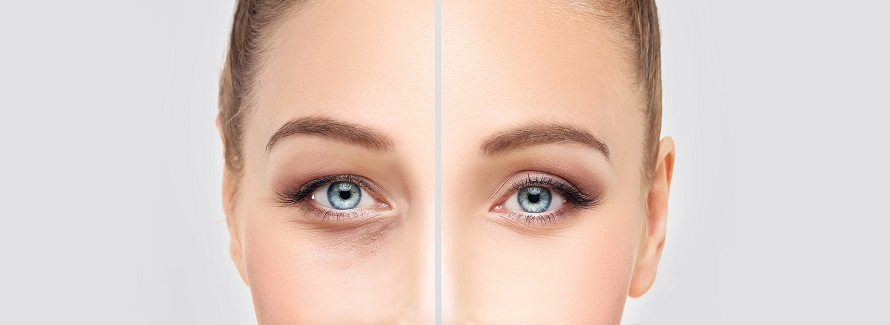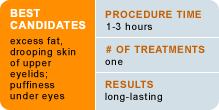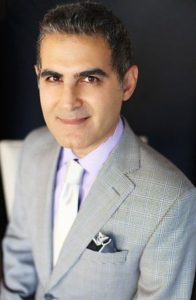Eyelid Surgery (Blepharoplasty) – Is an Eye Lift Right for You?

Reviewed by: Ali Ghafouri, MD, FACS

Eyelid surgery (also called blepharoplasty or eye lift) is one of the most popular cosmetic plastic surgeries. The area around eyes is rejuvenated by removing excess skin, re-positioning the fat, or tightening muscle from the upper and lower eyelids. Blepharoplasty improves “bags” (dark circles under the eyes) and corrects drooping or heavy upper eyelids. The eyes are the focal point of the face, and the purpose of this minimally invasive surgery is to provide a brighter and more youthful appearance. Eyelid surgery can also treat a medical condition called ptosis (drooping eyelid), which can be caused by poor muscle tone or nerve damage. Ptosis causes the eyelids to hang very low and block vision.
Blepharoplasty is often performed with other cosmetic surgeries such as a brow, cheek or face lift, as well as laser skin resurfacing to improve other signs of facial aging.
Another type of blepharoplasty known as Asian eyelid surgery is gaining in popularity worldwide. This procedure, performed on Asians with a “single eyelid,” creates a crease where none exists.
Why Eyelid Surgery?
As we age, the skin loses its elasticity and excess skin forms in the eye area. Fatty tissue herniates out can accumulate under the skin. Your eyes will look older because these aging processes leave them appearing tired, wrinkled or puffy. Even with good skincare, wrinkles, puffiness and drooping eyelids will catch up to you. Genetic factors and certain facial features can cause these aging effects in younger people. Plastic surgery may restore a youthful and refreshed appearance to your eyes.
Is it Right for Me?
The best candidates for blepharoplasty are physically healthy, emotionally stable and well-informed about the procedure. Ideal candidates are typically at least 35, though genetic factors may indicate treatment for younger people. Candidates may be excluded if they have any of the following conditions: dry eyes, uncontrolled high blood pressure or diabetes, and Graves’ disease. Male blepharoplasty may not be as common as female blepharoplasty, yet it nonetheless remains a popular procedure.
The Blepharoplasty Procedure
Your surgeon will make incisions along the natural crease line of the upper eyelid and possibly along the outer lower rim of the eyelid. When removing fatty tissue (but not skin) the surgeon may perform a transconjunctival blepharoplasty with an incision inside the lower eyelid. These incisions often reach the outer corners of the eyes. The incisions normally heal very nicely leaving no visible scar. Excess skin is removed, the redundant fat is trimmed or transposed to hollow areas, and loose muscles and tendons are tightened. Eyelid surgery is often performed under local anesthesia — while you are sedated, numbed and awake — in an outpatient surgery center, surgeon’s office or hospital. General anesthesia is not necessary for eyelid surgery. Be sure to discuss the appropriate type of anesthesia with your doctor and the anesthesia provider.
Depending on the extent of the procedure, time in surgery may be up to three hours. Patients return home typically within hours of the surgery.
After Surgery
Swelling and bruising is expected after the surgery. Usually, there is only very mild-to-moderate discomfort. Oral medications will help with pain and discomfort during your recovery, and an antibiotic will be prescribed to help prevent infection. Report any unmanageable pain to your doctor immediately.
You will receive a list of instructions to follow for several days, including:
- the proper way to clean your eyes
- use of cold compresses
- use of lubricating eye drops
- head elevation
- no makeup
- no alcohol
- no television
- no contact lenses
Stitches are removed about a week after surgery, or left to dissolve if absorbable sutures are used. Any bruising and swelling typically fades over the course of two-to-three weeks. Sunglasses and protective sun block are required for several weeks.
Normal activities can resume after about 10 days, though strenuous activities such as lifting, bending and exercise can resume after about three weeks.
The Eyes Have It
Ever wonder how others rate your age and vitality? It’s all in your eyes, according to a recent study out of the University of Tennessee Health Science Center in Memphis. The study findings, appearing in the February issue of Ophthalmology, may help you choose appropriate cosmetic surgery procedures, an important determination.
Using eye-tracking methods, researchers analyzed where 47 young adults most often fixed their gaze when asked to evaluate signs of age or fatigue among older people. Although the “eye area” represents a mere 21 percent of the total face, study participants spent almost half of their time looking at this part of the face while assessing age. By comparison, the nose garnered about 19.2 percent, followed by the forehead (13.3 percent) and the area between eyebrows (10.6 percent).
In assessments of fatigue, study participants spent 44.7 percent of the time looking at the eyes, followed by the nose (18 percent), forehead (13.7 percent) and the area between eyebrows (12.3 percent). Researchers noted that the “mouth area” might attract more attention if videos were used (rather than static images) and subjects were talking.
These findings may help explain why eyelid surgery (blepharoplasty) ranks as one of the top five cosmetic surgery procedures performed in the United States. According to the American Society for Aesthetic Plastic Surgery, it was also the most popular surgical procedure among people aged 51 to 64 in 2018. The findings also speak to the popularity of Botox to reduce the wrinkles around the eye such as crow’s feet, as well as the 11 lines between the eye brows.
Complications and Risks of Blepharoplasty
Following surgery, you may experience tearing, itchy, burning eyes, dry eyes, light sensitivity and blurred or double vision, which can persist for several days. Lubricating eye drops can relieve these conditions. There will also be some swelling and bruising around the eyes.
Sometimes patients have difficulty closing their eyes when asleep; though rare, this complication can be permanent. The lower lids may appear to be pulled down; this rare condition, called ectropion (or lid retraction), may require additional surgery. The eyes may also look somewhat asymmetrical requiring additional surgery. Scarring is another possible complication which can be treated with scar creams or steroid injections.
As with any surgery, eyelid surgery risks include infection and reaction to the anesthesia. You can avoid most complications by choosing the right plastic surgeon and following pre- and post-operative instructions. With proper precautions by the surgical team, complications are typically minimized or prevented.
Consult a Qualified Surgeon
Before deciding on blepharoplasty, discuss the options with a board-certified oculoplastic surgeon. The surgeon should have extensive experience performing blepharoplasty.
Surgeons can show you photos of other blepharoplasty patients with similar eyelids. You can look at these pictures to help create your individual surgical plan, as well as get a better idea of what to expect from the surgery.
Here are some questions to ask the surgeon:
- Ask about credentials, training and the number of times the treatment has been performed in the practice.
- Discuss the type of anesthesia to be used.
- Find out where surgery will be performed (surgical suite, hospital, other facility).
- Ask about the extent of the eyelid reshaping and any associated procedures you may be having.
- Ask about the recovery period and limitations on your activities.
- Ask for an explanation of risks, possible complications and likely results.
How Much Does it Cost?
Since blepharoplasty may be performed to reduce fatty tissue, skin and muscle, or tightening of the ligaments, the extent of the procedure can vary, which makes it difficult to give a range or an average eyelid surgery cost. In fact, each eye may have a different cost. The average cost for blepharoplasty is hard to estimate accurately until you are examined by a surgeon and have discussed a surgical plan.
Blepharoplasty surgery comprises three costs: anesthesia fees, facility fees and surgeon fees. The total fees can range from $3,000 to $4,000 or more, depending on whether upper or lower (or both) eyelids are done, and the extent of the procedure. In 2007, the national average for plastic surgeon fees for upper blepharoplasty was $2,480, according to the American Society for Aesthetic Plastic Surgery.
Some of the cost can be covered by insurance if the blepharoplasty is related to ptosis or loose upper lid skin causing vital field obstruction. Blepharoplasty for purely cosmetic reasons is not covered.
Asian Eyelid Surgery
Asian blepharoplasty — also known as “double eyelid surgery” — is the most common aesthetic plastic surgery procedure performed in Taiwan, Thailand, Hong Kong and other parts of the region where plastic surgery is taking off in popularity, according to a recent report from the International Society of Aesthetic Plastic Surgery (ISAPS). Asian blepharoplasty is also growing in popularity in the U.S.
Asian blepharoplasty does not have universal application. As many as 50 percent of Asians are born with double eyelids, and there is considerable variation in the crease position above the eyelash line from patient to patient. Some people who pursue Asian blepharoplasty may want to appear more “Western,” while others are interested in preserving their ethnicity and adding an eyelid crease.
The Procedure
Asian blepharoplasty reshapes the skin around the eyes to create an upper eyelid with a crease when no natural crease exists. This “double eyelid surgery” transforms a “single eyelid” into a “double eyelid.” Sometimes a procedure called an epicanthoplasty is performed at the same time as Asian blepharoplasty to remove the epicanthal fold of the upper eyelid that partially covers the inner corner of the eye.
Several Asian blepharoplasty techniques are available to create the double eyelid, including the full-incision, partial incision and no incision (DST) methods. Each has its advantages and applications depending on your unique anatomy and desired outcome. The specific procedure chosen depends on whether the surgeon is creating a crease, changing the height of an existing crease or completing an incomplete crease.
For example, a surgeon may use internal sutures within the eyelid to create a new, permanent crease. A different approach involves making a tiny incision where a natural crease might appear to remove a small amount of fat and muscle, thereby creating the crease. In other cases, extra skin or fat on the eyelid is removed surgically or by using a laser.
Choosing a Surgeon for Asian Blepharoplasty
Choosing a board-certified plastic surgeon with considerable experience performing this specialized procedure is important. The consultation is your chance to ask questions about the surgeon’s experience. Some of the other areas you will want to cover during the consultation include the technique he or she recommends in your case, the risks and complications associated with the procedure, length of recovery you can expect and the overall cost of the procedure. Also ask the surgeon if you can see an album of before and after pictures of previous patients to get an idea of his or her aesthetic approach.
When your initial consultation is over, you should have a better idea of whether this is the surgeon you want to perform your Asian blepharoplasty, as well as solid information about how you should prepare for surgery and beyond, the medications to avoid before and after surgery, and what steps you should take during recovery to make sure you heal well.
Risks of Asian Double Eyelid Surgery
Asian blepharoplasty, like all plastic surgeries, has risks and benefits that should be understood upfront. Complete recovery after double eyelid surgery may take up to several weeks. The incision takes several months to remodel and completely heal. Some asymmetry may correct itself during this period. Both eyes may not heal at the same rate.
Potential risks of Asian blepharoplasty include those commonly associated with traditional eyelid surgery: scarring, swelling, droopy eyelids, sagging eyebrows, asymmetry and general dissatisfaction with the cosmetic results.
During your initial consultation, your surgeon will provide you with a comprehensive eyelid surgery risk profile. He or she will also make sure you know what to expect during your eyelid surgery recovery.
How Much Does it Cost?
The cost of Asian eyelid surgery varies depending on where you have your surgery, but plan on spending somewhere between $3,000 and $5,000, with the higher end of the scale predominating in urban areas due to greater demand and higher overhead costs.
Typically, the eyelid surgery costs quoted by your surgeon include fees for the surgeon, anesthesia and operating facility. Be sure to understand exactly what’s covered before committing to surgery. There may be other costs involved such as painkillers, antibiotics and other medications related to the surgery like artificial tears, and ancillary surgical supplies like cold compresses. You also may need sunglasses to protect your eyes postoperatively and possibly camouflage make-up to cover any bruising that may occur. If costs are prohibitive, financing options may be available.
About the Reviewer of This Article
 Ali Ghafouri, MD, FACS, is an ophthalmic plastic and facial cosmetic surgeon practicing in Scottsdale and Phoenix, AZ. Dr. Ghafouri has extensive experience and expertise performing plastic surgery of the eyelids, orbit and tear drainage, in addition to having extensive training with skin cancer reconstruction treatments.
Ali Ghafouri, MD, FACS, is an ophthalmic plastic and facial cosmetic surgeon practicing in Scottsdale and Phoenix, AZ. Dr. Ghafouri has extensive experience and expertise performing plastic surgery of the eyelids, orbit and tear drainage, in addition to having extensive training with skin cancer reconstruction treatments.
Dr. Ghafouri is a graduate of Michigan State University, where he received both his Bachelor of Science and medical degrees, before completing his residency in ophthalmology at New York University School of Medicine North Shore University Hospital. He subsequently completed a sub-specialty fellowship in oculoplastic and orbital surgery at Baylor College of Medicine Cullen Eye Institute in Houston, TX.


